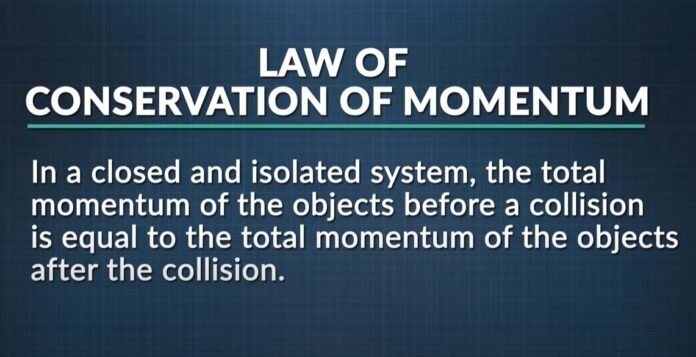What is the Law of Conservation of Momentum?
The momentum of an object is the product of the quantities of velocity and mass of an object. It is a vector quantity. Conservation of momentum is a fundamental law of physics, which states that for two or more bodies that are in an isolated system acting upon each other, their total momentum will remain constant unless an external force is applied to it. So that the momentum of the body can neither be created nor be destroyed, however, it can be changed through the action of forces as described by Newton’s laws of motion.
Derivation of Law of Conservation of Momentum
Considers two colliding bodies A and B whose masses are and with initial velocities u1 and u2 before the collision and final velocities v2 and v2 after the collision. The time of contact between two bodies is given as t. The masses of an object will be the same before and after the collision.
Change in the momentum of body A =
Change in the momentum of body B =
From third law of motion, the two forces are equal and opposite,
Therefore this is the equation of law of conservation of momentum where
is the total momentum of bodies A and B before the collision and is the total momentum of bodies A and B after the collision.
Newton’s third law states that for a force applied by body A on body B then body B exerts back an equal magnitude of force but opposite in direction.
Law of Conservation of Momentum examples
The law of conservation of momentum is mainly applied to all physical processes. Here are some examples:
- Rockets motion – At the end of a rocket, there is a gas chamber from where the gas is ejected at a very high velocity. The total momentum before the ejection is zero. The ejection of gas causes the rocket to gain velocity and acceleration in an opposite direction. This is due to the result of momentum conservation.
- Ejection of bullets from a gun – Before the firing of a gun, the gun and the bullet both are at rest. When a bullet is shot from a gun, the bullet gains forward motion and the gun suffers the recoil momentum that results in the conservation of momentum.
- Collision: When two objects collide with each other, The conservation of momentum and energy manages the collision of objects. Like when a person in a boat jumps into the water, the boat gets slightly jerked.
- Firecrackers and Air-filled balloons are also due to the conservation of momentum.
Solved problems of the Law of Conservation of Momentum
1. What will be the velocity of a bullet of mass which is fired from a gun of mass ? The recoil velocity attained by the gun is .
Solution: Given:
Mass of bullet,
Mass of the gun,
The velocity of a bullet,
Recoil velocity of the gun,
From the formula for the law of conservation of momentum,
Here, Initial velocity of the bullet,
Initial recoil velocity of a gun,
Therefore, the recoil velocity of the pistol is . The negative sign in velocity implies that the recoil velocity is opposite to that of the velocity of the bullet.
Recommended Articles:
Derivation of Equation of Motion: Introduction, Methods, And Equations
Derivation of Escape Velocity: Introduction, Formula, And Earth
Hall Effect: Introduction, Theory, Principle, Principle, And Applications
Heat Equation: Introduction, Assumptions, Derivation, And Applications
Derivation of Kinetic Energy
The product or multiplication of the mass and velocity of an object is known as momentum. When an object is at rest then the momentum of the body then the momentum would be zero, as the velocity is zero which tends to momentum zero. It is represented as As momentum has both magnitude and direction, it is a vector quantity. If there is no external force acting on the isolated system, then the total momentum remains constant. So that the force exerted on the system is zero if the total linear momentum of the system remains constant. If there is no external torque applied then the angular momentum is conserved. Momentum is expressed as Where denotes the mass of the unit and is the velocity of unit of an object. So the SI unit of momentum is . Some of the examples are The motion of the rocket Derivation Of Law Of Conservation Of Momentum FAQs
What do you mean by momentum?
Momentum is a scalar or a vector quantity?
What do you mean by the concept of conservation of momentum?
Determine the SI unit for momentum.
Write some examples of the law of conservation of momentum.
Air-filled balloons
System of guns and bullets
Collision of an object
